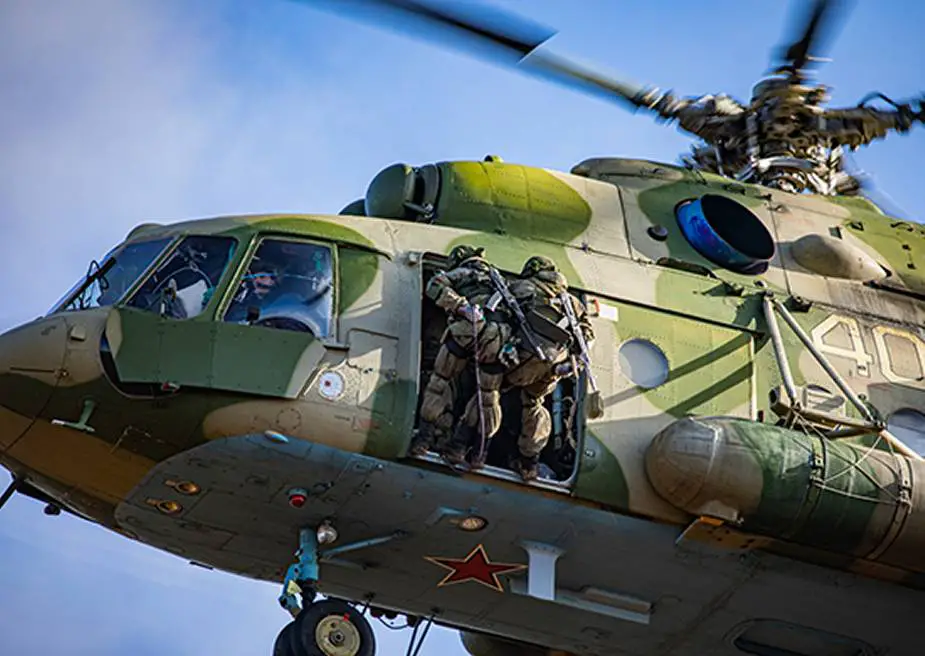A new reform is taking place in the Russian Airborne Forces. Air assault and paratrooper units have to meet the requirements of modern armed conflicts to the maximum. The Airborne Forces are creating units of a new type, commando detachments and companies, drone and electronic warfare units. Paratroopers will soon enjoy fire support of their own artillery brigade and a helicopter brigade, the Independent Military Review writes.
Follow Army Recognition on Google News at this link

Russian soldiers fast-rope from an Mi-8 AMTSh Terminator, March 2021 (Russian MoD)
The first reports about the creation of “new type” units in the Airborne Forces appeared in late 2017. They are companies and battalions that operate on helicopters. They are unofficially called airmobile units. The experiment to create such units was held in the 31st air assault brigade in Ulyanovsk. One of the battalions received a new staff matrix. Its paratroopers participated in all experimental drills. Combat airborne vehicles and armored personnel carriers were excluded from the matrix. The number of riflemen in platoons and detachments increased. The firepower of airmobile units was strengthened by a larger number of antitank missiles, large-caliber machine guns and automatic grenade launchers.
The Defense Ministry officially reported the creation of airmobile units in the autumn of 2018 when they participated in Vostok-2018 exercise. The experimental battalion was later engaged in Center-2019 and Caucasus-2020 exercises. The paratroopers landed in the tactical rear and operated as a mobile reserve against advancing adversaries.
It was reported in the summer of 2020 that the new airmobile units and airborne commandos will be the first to receive Typhoon-VDV armored vehicles. So far, they are transportation means and vehicles armed with a 30mm automatic gun. The airmobile units will later receive armored vehicles with Kornet antitank missiles of a longer firing range.
Caucasus-2020 exercise demonstrated a new operational formation element — mobile echelon. In contrast to traditional operational elements, which have a fixed frontline and movement direction, the mobile unit can operate in a broad radius upon a decision of the command. It can rapidly create a defense line in a dangerous direction or hold a retreating adversary. Airmobile units on helicopters are its backbone.
The experiment was recognized as successful in late 2020. Airborne Forces Commander Colonel-General Andrey Serdyukov said in December that his forces would get air assault formations of a new type for independent operations in the hostile rear in interaction with army aviation.
In early 2021, his deputy Major-General Anatoly Kontsevoi said battalions of a new type would be formed in all air assault regiments and brigades. The work has to be completed by the end of the year.
Until recently, all airborne divisions had two paratrooper or air assault regiments. In 2015, then Commander of the Airborne Forces Colonel-General Vladimir Shamanov said the divisions would get a third regiment. The new regiments signaled the creation of airmobile battalions. A division is likely to have three battalions of a new type — one in each regiment. The third air assault regiment is necessary to keep the combat strength of the division.
New-type units enjoy better maneuverability and flexibility against traditional air assault units. Helicopters can deliver them in several hours to hundreds of kilometers and the units will immediately engage in combat. The armor of ordinary air assault battalions provides them with higher firepower and sustainability in the battlefield.
Besides helicopters, the airmobile units will move on Typhoon-VDV vehicles and fight on them. However, the vehicles with a 30mm automatic gun are inferior in firepower to combat airborne vehicles and armored personnel carriers.
© Copyright 2021 TASS / Army Recognition Group SPRL. All rights reserved. This material may not be published, broadcast, rewritten or redistributed.
















